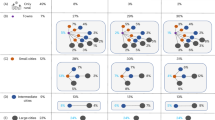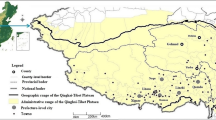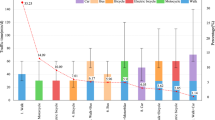Abstract
Public transport (PT) accessibility is crucial to inclusive, sustainable urban development, as codified in United Nations Sustainable Development Goal (SDG) 11. Growth in PT accessibility can mask wide variation near and within even major cities. Contrary to the 2023 SDG report’s claim of over 80% convenient PT access in major Chinese cities, we find that only two cities’ villages meet the benchmarks and lowest rate, at just 34%. Commute time improvements depend heavily on population dynamics, but new bus station placements often fail to reflect these shifts. Meanwhile, although fares to city centers generally decreased, the proportion of village populations covered by high-fare routes rose noticeably in some cities. These results reveal how additional travel time, higher costs and changing demographics can impede villagers’ access to urban services. The narrow focus on a ‘10-minute’ performance metric risks driving suboptimal planning decisions that overlook broader travel burdens. A more nuanced, population-responsive approach to planning is needed to ensure that SDG 11 remains inclusive for all urban communities.
This is a preview of subscription content, access via your institution
Access options
Subscribe to this journal
Receive 12 digital issues and online access to articles
$119.00 per year
only $9.92 per issue
Buy this article
- Purchase on SpringerLink
- Instant access to full article PDF
Prices may be subject to local taxes which are calculated during checkout




Similar content being viewed by others
Data availability
The minimum dataset supporting this study (2017–2023 village and road-network shapefiles for the ten studied cities) is available via Zenodo at https://doi.org/10.5281/zenodo.15541605 (ref. 50). Additional route and station data are available via OSM at https://www.openstreetmap.org/ and were supplemented with data extracted from AutoNavi using a custom Python script (BeautifulSoup4 v.4.10.0). Village data are derived from the official website of the Chinese National People’s Government and are available via the Chinese National People’s Government at http://english.www.gov.cn/, with data samples from the sixth batch of traditional villages available at the Chinese National People’s Government via https://www.gov.cn/zhengce/zhengceku/2023-03/21/content_5747708.htm (list in Chinese). The administrative area data for each village, public service centers data and typical bus departure frequency information were individually queried on local government websites. These data are available upon request from the authors. The WorldPop high-resolution population counts are available from WorldPop at https://hub.worldpop.org/geodata/listing?id=69.
Code availability
The Python script used to extract and process additional bus-route data from AutoNavi (Gaode Map) with BeautifulSoup4 (v.4.9.3) is available via Code Ocean at https://doi.org/10.24433/CO.2745477.v1.
References
Saurman, E. Improving access: modifying Penchansky and Thomas’s theory of access. J. Health Serv. Res. Policy 21, 36–39 (2016).
Penchansky, R. & Thomas, J. W. The concept of access: definition and relationship to consumer satisfaction. Med. Care 19, 127–140 (1981).
Sampaio, B. R., Neto, O. L. & Sampaio, Y. Efficiency analysis of public transport systems: lessons for institutional planning. Transp. Res. A 42, 445–454 (2008).
Pereira, R. H. M., Schwanen, T. & Banister, D. Distributive justice and equity in transportation. Transp. Rev. 37, 170–191 (2017).
Levinson, D. M. The 30-Minute City: Designing for Access (Network Design Lab, 2019).
Weiss, D. J. et al. A global map of travel time to cities to assess inequalities in accessibility in 2015. Nature 553, 333–336 (2018).
United Nations. Transforming our World: The 2030 Agenda for Sustainable Development (United Nations Department of Economic and Social Affairs, 2015).
Guo, H. Sustainable Development Goals Series: Big Data for Sustainable Development Goals (Science Press and Springer Nature, 2024).
Yu, Z. & Zhao, P. J. The factors in residents’ mobility in rural towns of China: car ownership, road infrastructure and public transport services. J. Transp. Geogr. 91, 102950 (2021).
Yu, Z., Yuan, D. D., Zhao, P. J., Lyu, D. & Zhao, Z. F. The role of small towns in rural villagers’ use of public services in China: evidence from a national-level survey. J. Rural Stud. 100, 103011 (2023).
Vale, D. & Lopes, A. S. Accessibility inequality across Europe: a comparison of 15-minute pedestrian accessibility in cities with 100,000 or more inhabitants. npj Urban Sustain. 3, 55 (2023).
Weiss, D. J. et al. Global maps of travel time to healthcare facilities. Nat. Med. 26, 1835–1838 (2020).
Hierink, F. et al. Differences between gridded population data impact measures of geographic access to healthcare in sub-Saharan Africa. Commun. Med. 2, 117 (2022).
Nelson, A. et al. A suite of global accessibility indicators. Sci. Data 6, 266 (2019).
Wang, Z., Xu, J., Fang, C., Xu, L. & Qi, Y. The study on county accessibility in China: characteristics and effects on population agglomeration. J. Geogr. Sci. 21, 18–34 (2011).
Marwal, A. & Silva, E. Literature review of accessibility measures and models used in land use and transportation planning in last 5 years. J. Geogr. Sci. 32, 560–584 (2022).
Liang, H. et al. Sponet: solve spatial optimization problem using deep reinforcement learning for urban spatial decision analysis. Int. J. Digit. Earth 17, 2299211 (2024).
Zhong, Y. et al. ReCovNet: Reinforcement learning with covering information for solving maximal coverage billboards location problem. Int. J. Appl. Earth Obs. Geoinf. 128, 103710 (2024).
Singer, M. E., Cohen-Zada, A. L. & Martens, K. Core versus periphery: examining the spatial patterns of insufficient accessibility in U.S. metropolitan areas. J. Transp. Geogr. 100, 103321 (2022).
Wu, H., Levinson, D. & Sarkar, S. How transit scaling shapes cities. Nat. Sustain. 2, 1142–1148 (2019).
Logan, T. M. et al. The x-minute city: measuring the 10, 15, 20-minute city and an evaluation of its use for sustainable urban design. Cities 131, 103924 (2022).
Dixit, M. & Sivakumar, A. Capturing the impact of individual characteristics on transport accessibility and equity analysis. Transp. Res. D 87, 102473 (2020).
Lopes, A. S., Moura, F., Orozco-Fontalvo, M. & Vale, D. Mobility as a service and socio-territorial inequalities: a systematic literature review. J. Transp. Land Use 16, 215–240 (2023).
Lucas, K. Transport and social exclusion: where are we now? Transp. Policy 20, 107–115 (2012).
Moreno-Monroy, A. I., Lovelace, R. & Ramos, F. R. Public transport and school location impacts on educational inequalities: insights from São Paulo. J. Transp. Geogr. 67, 110–118 (2018).
Bastiaanssen, J., Johnson, D. & Lucas, K. Does better job accessibility help people gain employment? The role of public transport in Great Britain. Urban Stud 59, 301–322 (2022).
Fang, Y., Lu, H., Huang, Z. & Zhu, Z. Spatiotemporal distribution of chinese traditional villages and its influencing factors. Econ. Geogr. 43, 187–196 (2023) (in Chinese).
Wang, H. The role of informal ruralization within China’s rapid urbanization. Nat. Cities 1, 205–215 (2024).
Chen, X. W. The core of China’s rural revitalization: exerting the functions of rural area. China Agr. Econ. Rev. 12, 1–13 (2020).
Zheng, N., Wang, S., Wang, H. & Ye, S. Rural settlement of urban dwellers in China: community integration and spatial restructuring. Hum. Soc. Sci. Commun. 11, 188 (2024).
Long, H. L., Ma, L., Zhang, Y. N. & Qu, L. L. Multifunctional rural development in China: pattern, process and mechanism. Habitat Int. 121, 102530 (2022).
Neutens, T., Schwanen, T., Witlox, F. & De Maeyer, P. Equity of urban service delivery: a comparison of different accessibility measures. Environ. Plan. A 42, 1613–1635 (2010).
Vale, D. S. & Pereira, M. The influence of the impedance function on gravity-based pedestrian accessibility measures: a comparative analysis. Environ. Plan. B 44, 740–763 (2016).
Rahul, T. & Verma, A. A study of acceptable trip distances using walking and cycling in Bangalore. J. Transp. Geogr. 38, 106–113 (2014).
Millward, H., Spinney, J. & Scott, D. Active-transport walking behavior: destinations, durations, distances. J. Transp. Geogr. 28, 101–110 (2013).
Weinstein Agrawal, A., Schlossberg, M. & Irvin, K. How far, by which route and why? A spatial analysis of pedestrian preference. J. Urban Des. 13, 81–98 (2008).
Kesarovski, T. & Hernández-Palacio, F. Time, the other dimension of urban form: measuring the relationship between urban density and accessibility to grocery shops in the 10-minute city. Environ. Plan. B 50, 44–59 (2023).
Wu, C., Chen, M. M., Zhou, L., Liang, X. J. & Wang, W. Identifying the spatiotemporal patterns of traditional villages in China: a multiscale perspective. Land 9, 449 (2020).
Wu, K. et al. Analysis on the geographical pattern and driving force of traditional villages based on GIS and Geodetector: a case study of Guizhou. China. Sci. Rep. 13, 20659 (2023).
Chen, W. X. et al. Spatio-temporal characteristics and influencing factors of traditional villages in the Yangtze River Basin: a geodetector model. npj Herit. Sci. 11, 111 (2023).
Zhao, P. & Hu, H. Geographical patterns of traffic congestion in growing megacities: big data analytics from Beijing. Cities 92, 164–174 (2019).
Feldmeyer, D., Nowak, W., Jamshed, A. & Birkmann, J. An open resilience index: crowdsourced indicators empirically developed from natural hazard and climatic event data. Sci. Total Environ. 774, 145734 (2021).
Sun, L. Q., Chen, J., Li, Q. L. & Huang, D. Dramatic uneven urbanization of large cities throughout the world in recent decades. Nat. Commun. 11, 5366 (2020).
Milojevic-Dupont, N. et al. Learning from urban form to predict building heights. PLoS ONE 15, e0242010 (2020).
Herfort, B., Lautenbach, S., Porto de Albuquerque, J., Anderson, J. & Zipf, A. A spatio-temporal analysis investigating completeness and inequalities of global urban building data in OpenStreetMap. Nat. Commun. 14, 3985 (2023).
Zhang, L., Tao, L., Yang, F., Bao, Y. & Li, C. Promoting green transportation through changing behaviors with low-carbon-travel function of digital maps. Humanit. Soc. Sci. Commun. 11, 298 (2024).
Lloyd, C. T. et al. Global spatio-temporally harmonised datasets for producing high-resolution gridded population distribution datasets. Big Earth Data 3, 108–139 (2019).
Xu, Y., Ho, H. C., Knudby, A. & He, M. Comparative assessment of gridded population data sets for complex topography: a study of Southwest China. Popul. Environ. 42, 360–378 (2021).
Chen, Y. H., Xu, C. C., Ge, Y., Zhang, X. X. & Zhou, Y. N. A. 100 m gridded population dataset of China’s seventh census using ensemble learning and big geospatial data. Earth Syst. Sci. Data 16, 3705–3718 (2024).
Chen, Z. Public transport accessibility in villages in and around major Chinese cities. Zenodo https://doi.org/10.5281/zenodo.15541605 (2025).
Xinliang, X. China multi-year administrative boundary dataset at the prefecture-level. Resource and Environment Science and Data Center https://doi.org/10.12078/2023010102 (2023).
Acknowledgments
This work was supported by the National Social Science Fund of China, General Program (grant number 24BMZ054) to Z.C.
Author information
Authors and Affiliations
Contributions
Z.C. designed the study, drafted the initial paper and led the revisions. Xiaowei Li and B.L. conducted the data analysis. S.W. and Xiao Li were responsible for large-scale data collection and web scraping. X.Y. reviewed the analysis and contributed to the figure design. J.L. and Z.W. supervised the project. All authors reviewed and approved the final paper.
Corresponding author
Ethics declarations
Competing interests
The authors declare no competing interests.
Peer review
Peer review information
Nature Cities thanks the anonymous reviewers for their contribution to the peer review of this work.
Additional information
Publisher’s note Springer Nature remains neutral with regard to jurisdictional claims in published maps and institutional affiliations.
Extended data
Extended Data Fig. 1 Changes in public transport fares and high-fare coverage in major cities, 2017–2023.
Box-and-whisker plots (left y-axis) summarize the minimum single-trip fare (CNY) available at each village bus stop that offers at least one city-bound route (n = exact number of independent stops, printed below each city name). Center line = median; box = 25th–75th percentiles (IQR); whiskers = minimum and maximum observations; gray dots mark values lying more than 1.5 × IQR outside the box. Repeated timetable checks at the same stop were averaged and therefore do not constitute additional replicates. Blue circles (right y-axis) show the share of villagers whose nearest stop provides only high-fare services (starting fare > 5 CNY, for example tourist, express or inter-city buses). No box is shown for Wuhan in 2017 due to fewer than three qualifying stops. Cities are ordered (left-to-right) by the 2017–2023 change in population residing within a 10-minute walking-transit zone. Data collection and processing details are provided in Methods 5.3.4.
Extended Data Fig. 2 Standardized Distribution of Bus Station Growth and Population Change, 2017–2023.
a). Red and blue curves represent changes in bus station counts and population, respectively, within each radius ‘r’ band (excluding inner radii). Values are standardized using Z-score normalization for comparability. The density-weighted CV indicates the uniformity of these changes across 20 concentric rings, with lower values representing more even spatial distribution. The ‘avg. r’ value denotes the average village radius of each city. Duplicate stations with the same name were excluded. Cities are arranged from top to bottom according to changes in the population within 10-minute walking transit zone. b). Pearson correlation between ring-level population change and bus-station growth (2017–2023); two-sided Pearson r (df = 18), n = 20 concentric rings per city. Exact P values: Chongqing p = 0.0002 (0.350–0.866); Suzhou p < 0.0001 (0.668–0.942); Tianjin p = 0.061 (–0.714–0.055); Beijing p = 0.847 (–0.405–0.479); Chengdu p = 0.827 (–0.397–0.486); Wuhan p = 0.792 (–0.451–0.434); Hangzhou p = 0.378 (–0.556–0.312); Shanghai p = 0.048 (–0.030–0.726); Nanjing p = 0.0008 (0.444–0.891); Guangzhou p = 0.0003 (0.567–0.921). Numbers in parentheses denote the 95 % confidence interval for each r. No adjustment for multiple comparisons was applied.
Supplementary information
Supplementary Code 1.
Python script for bus-route data extraction.
Source data
Source Data Fig. 3.
Statistical data for 10_min_walking_transit population and proportions.
Source Data Fig. 4.
Statistical data for walking/riding/transfer/stopping time distributions.
Source Data Extended Data Fig. 1.
Statistical data for village-level fares and the proportions of residents served only by high-fare routes, underpinning the box-and-whisker plots and blue-dot percentages.
Source Data Extended Data Fig. 2.
Statistical data for ring-level station and population densities across 20 concentric buffers per village, used to derive the Z-score curves, density-weighted CVs and Pearson r coefficients.
Rights and permissions
Springer Nature or its licensor (e.g. a society or other partner) holds exclusive rights to this article under a publishing agreement with the author(s) or other rightsholder(s); author self-archiving of the accepted manuscript version of this article is solely governed by the terms of such publishing agreement and applicable law.
About this article
Cite this article
Chen, Z., Li, X., Liu, B. et al. Public transport accessibility in villages in and around major Chinese cities. Nat Cities 2, 749–758 (2025). https://doi.org/10.1038/s44284-025-00277-z
Received:
Accepted:
Published:
Issue date:
DOI: https://doi.org/10.1038/s44284-025-00277-z



